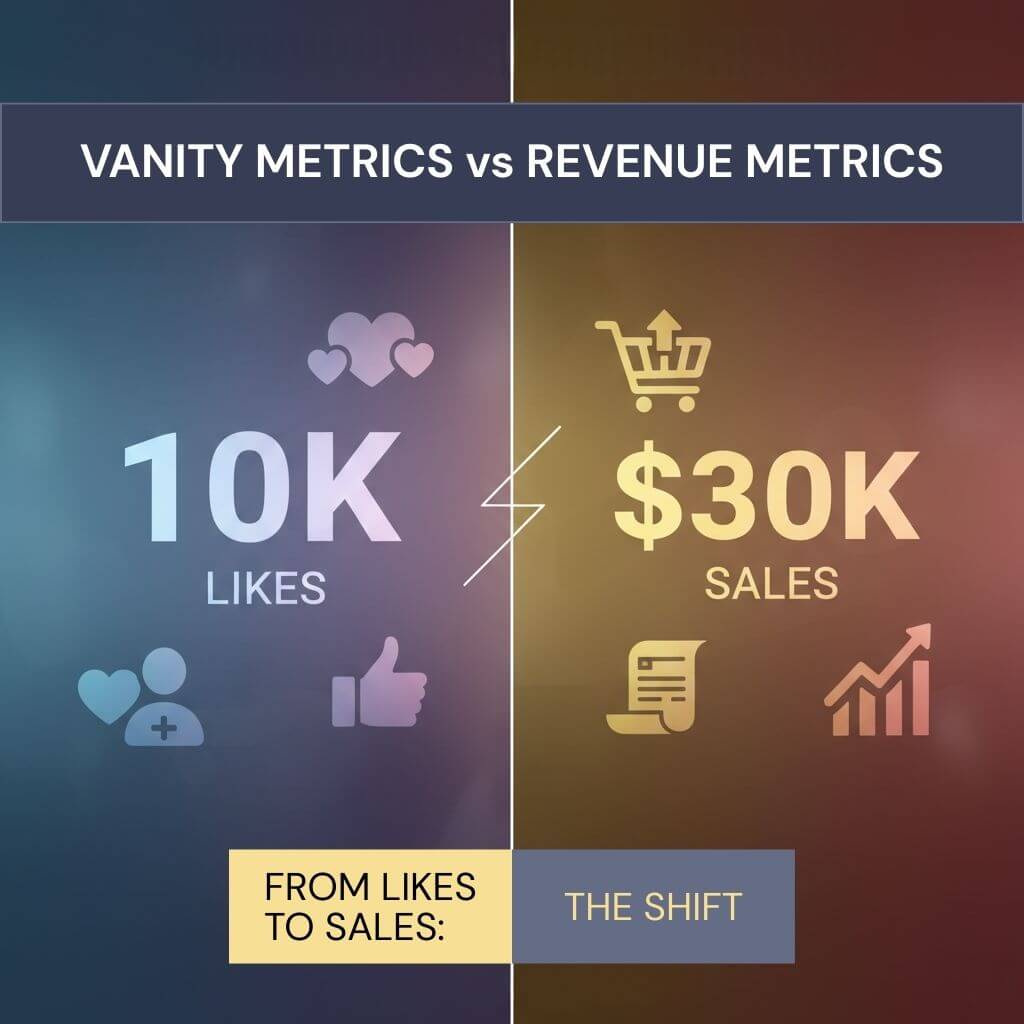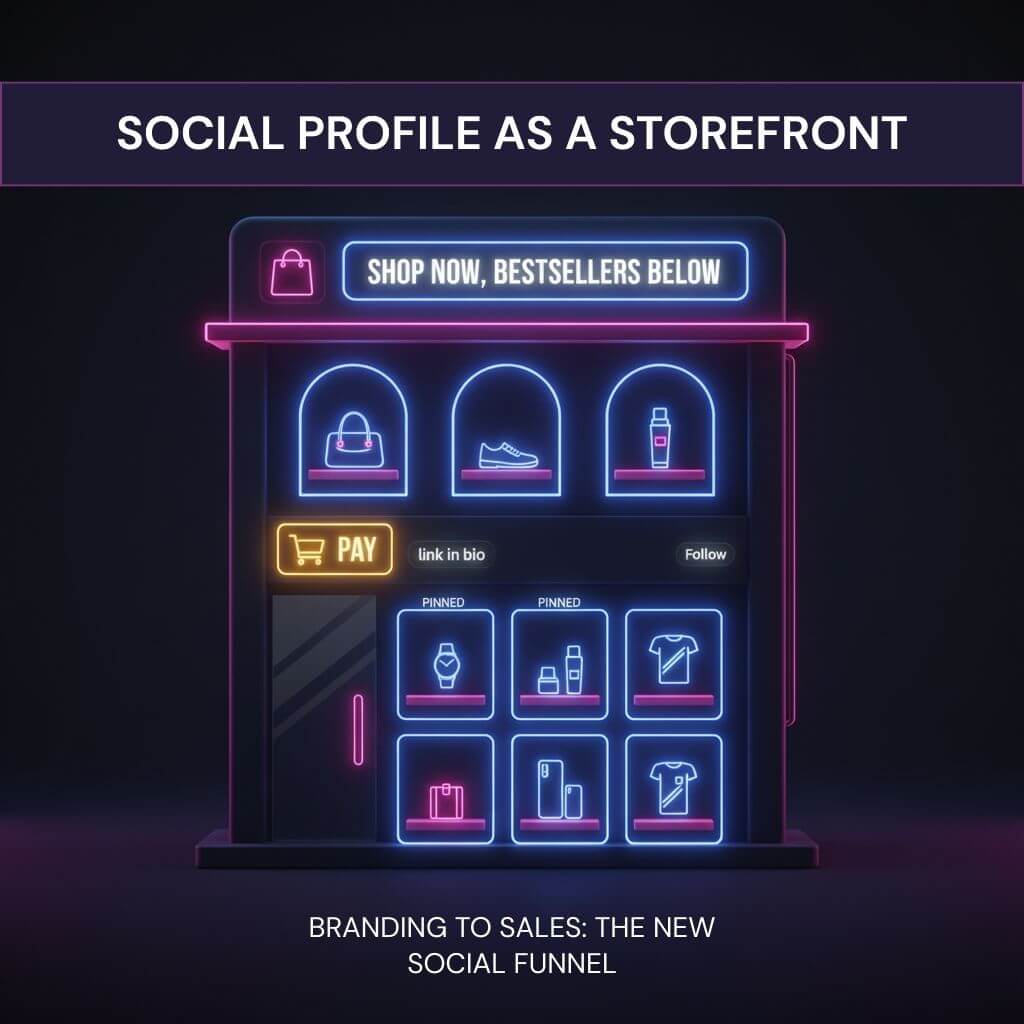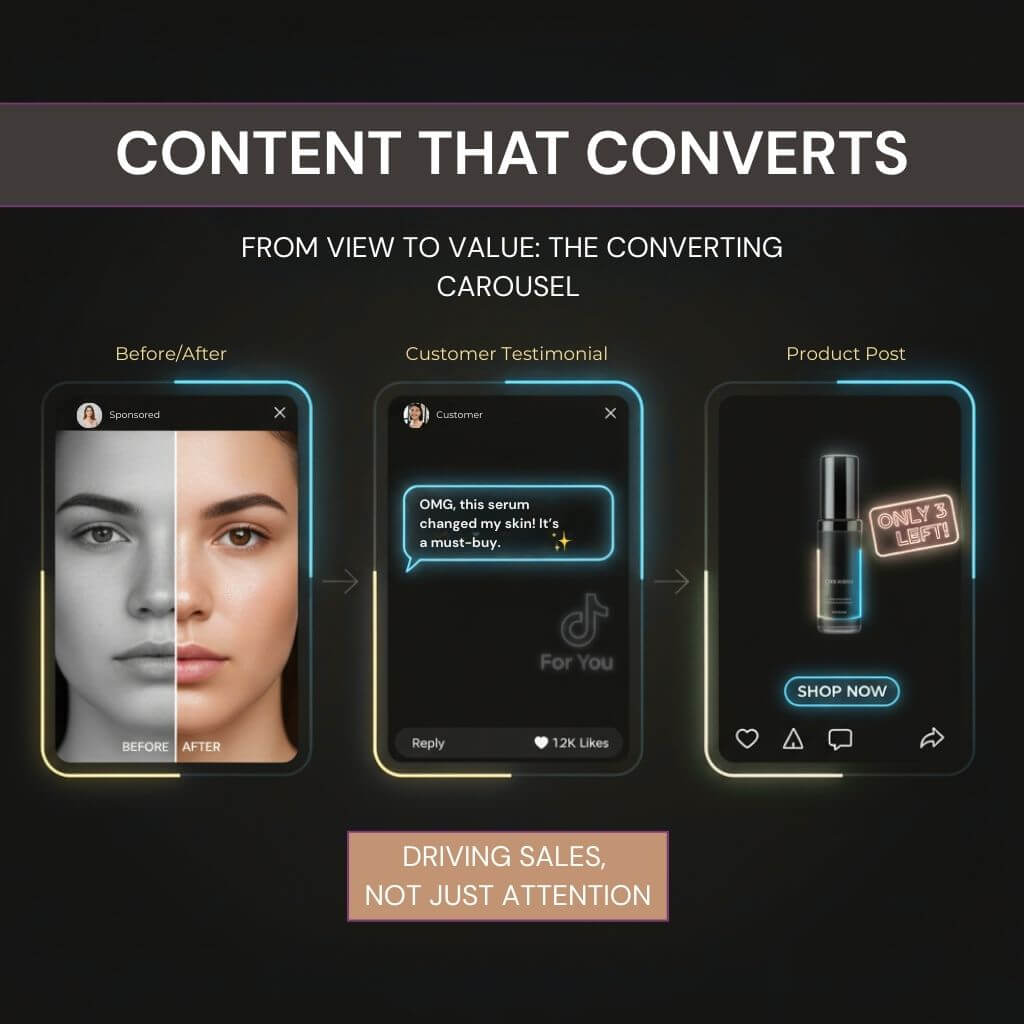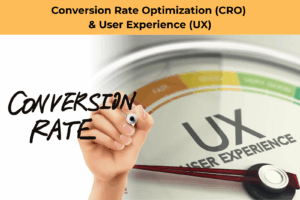Remember when everyone said social media would revolutionize sales? Well, it did, just not for every business.
Walk into any marketing meeting and you’ll hear the same metrics…”We’re up to 10K followers!” “Our engagement rate hit 5%!” “That reel got 50,000 views!” Cool. But what’s selling?
The disconnect is wild. Businesses are spending 20 hours a week creating content, paying social media managers, investing in design tools and then hoping customers somehow figure out how to buy from them. It’s like opening a store with no cash register and wondering why revenue is down.
Meanwhile, some random brand with 2,000 followers is consistently pulling $30K months from Instagram alone. Not because they’re social media geniuses. They just understand that social platforms are where people discover products now. Where they research. Where they buy. And if you’re not set up for that, you’re just providing free entertainment.
The good news is that fixing this doesn’t require starting over. Your audience is already there. The platforms have built all the selling features you need. You just need to stop treating social media like a branding exercise and start treating it like the sales channel it is. In this guide, we’ll show you how. Simple as that. Ready to dive in? Let’s go!

1. Shift Your Mindset: From Vanity Metrics to Revenue Metrics
Before you change your content or ad strategy, you need to fundamentally redefine what success means on social media. Yes, likes and follower counts feel good but they don’t pay your bills (unless you know how to monetize them).
Vanity metrics like likes, comments, and follower counts can indicate brand awareness, but they rarely translate to actual revenue. We’ve seen accounts with 100K followers making less money than accounts with 5K highly engaged buyers. The difference? The smaller accounts measure what matters and their audience is primed to buy.
Instead of chasing popularity, shift your focus entirely to revenue metrics such as conversions, qualified leads, sales, and repeat customers.
Take this real example as an, well, example…a fashion boutique with 20,000 Instagram followers was struggling to break even. Their posts got hundreds of likes, but their website barely saw traffic. Why? No product tags, no clear CTAs, no path from “this is cute” to “buy now.” Meanwhile, their competitor with just 2,000 followers was killing it. Every post had shoppable tags, stories always included product stickers, and their bio link went straight to their bestsellers. Guess who was making money?
If you want to be in the later category here are a few actions steps you can take. Stop celebrating engagement rates and start tracking metrics that matter:
- Click-through rate (CTR) to your website or product pages
- Conversion rate from social traffic
- Customer acquisition cost (CAC) from social channels
- Revenue per follower (total social revenue ÷ follower count)
These numbers tell you if your social media is actually working as a sales channel, not just an entertainment platform.

2. Optimize Profiles for Conversions
Think of your social media profile as a landing page. Every visitor should know exactly what you sell and how to buy it within three seconds of landing there.
Your bio is prime real estate that most businesses waste on clever taglines or vague descriptions. “Spreading joy through fashion” tells me nothing. “Custom jewelry ready to ship. Shop our bestsellers below” tells me everything. Stop trying to be poetic and start being clear. Tell people what you sell and what they should do next. “Book your free consultation,” “Get 20% off your first order,” “See our work below”…these work because they remove the guesswork.
That “link in bio” everyone fights over needs serious strategy. Linking to your homepage is lazy and ineffective – it forces customers to hunt for what caught their attention. Instead, use a dedicated landing page that matches what you’re promoting. Posted about your new collection? Link directly to it. Sharing customer transformations? Link to that specific service booking page. Tools like Linktree work, but a simple mobile-optimized page on your own site works better and keeps the sale on your platform.
Don’t ignore the features platforms give you for free. Instagram Highlights sitting empty while you complain about low sales means you’re leaving money on the table. Pin your best offers, FAQs, testimonials, and process videos up top where everyone can see them. TikTok’s pinned videos should be your best converters, not your most viral dancers.
For example, a skincare brand we worked with made one simple change. They swapped their homepage link for a “bestsellers” page and Instagram sales jumped 40% that month. Same followers, same content, just a smarter path to purchase.
3. Create Content that Sells (Not Just Entertains)
Every piece of content you post should move someone closer to buying. If it doesn’t, you’re just creating free entertainment for Meta and TikTok. Here’s what content that actually converts looks like:
- Educate your way to sales: Don’t just show your product, show it solving real problems. A cleaning service posting before/after photos beats “Happy Monday!” posts every time. Tutorial videos, process breakdowns, myth-busting posts, these build trust while demonstrating exactly why someone needs what you’re selling. That fitness coach showing proper form corrections? They’re really showing why you need their program.
- Make them see themselves as customers: Lifestyle content only works if people can picture themselves in it. Instead of perfectly staged product shots, show your stuff in real situations. Help people visualize your product in their life, not in a catalog.
- Let your customers sell for you: Social proof beats any sales pitch you could write. Screenshot those five-star reviews. Repost customer success stories. Share the DM where someone says your product changed their life. When prospects see people like them getting results, their credit card starts burning a hole in their pocket.
- Create urgency that actually works: “Limited time offer” is overplayed. But “only 3 spots left for November” or “this colorway retiring Friday” creates real urgency. Show inventory numbers. Use countdown stickers. Make scarcity visible and believable. Just don’t cry wolf, fake urgency kills trust faster than anything.
A luxury diffuser brand we know doubled conversions by ditching their pretty product shots for customer unboxing videos and real homes using their products. Same product, same price, but now people could actually see themselves buying it.
4. Leverage Paid Advertising the Right Way
Organic reach is dead. If you’re serious about sales, you need ads. But throwing money at “boost post” and targeting “people who like fitness” is just funding Zuckerberg’s yacht (or his second one). Smart paid advertising targets people who are ready to buy.
- Start with people who already know you: Remarketing to website visitors costs less and converts higher than any cold audience. These people already browsed your productsm they just need a nudge. That person who spent five minutes looking at your pricing page? They’re one targeted ad away from converting. Set up your pixel, create audiences based on specific page visits, and watch your cost per acquisition drop.
- Let the robots sell for you: Dynamic Product Ads are like having a salesperson follow customers around showing them exactly what they looked at. Someone browsed your blue sneakers but didn’t buy? Facebook will automatically show them those exact sneakers, maybe with free shipping this time. Set it up once, let it run forever.
- Clone your best customers: Lookalike audiences find people who act like your existing buyers. Upload your customer list, let the platform find their twins, and market to people predisposed to buy from you. Way smarter than targeting broad interests and hoping for the best. A 1% lookalike of your purchasers beats “women aged 25-45 interested in fashion” every single time..
Real example: A German moving company stopped running generic “we move stuff” ads to everyone in Berlin. Instead, they remarketed to quote page visitors with “Still thinking about that move? Here’s 10% off.” Result? Three times more bookings at half the cost per acquisition.
Stop paying to introduce yourself to strangers. Start selling to people who already want what you have.
5. Engage Like a Salesperson, Not a Celebrity
Your followers aren’t fans, they’re potential customers. And when they comment or DM you, they’re raising their hand to buy. Ignoring them is like watching someone walk into your store and refusing to acknowledge them.
- Treat every message like money: That DM asking “is this still available?” isn’t spam, it’s someone with their wallet out. Yet most businesses take 3-5 days to respond, if ever. By then, they’ve already bought from your competitor who answered in an hour. Set up notifications, check messages multiple times daily, and respond like your rent depends on it. Because it does.
- Stop typing the same answers 50 times: Create templates for your common questions from pricing, sizing, availability, to shipping. But customize them slightly so you don’t sound like a bot. “Hi Sarah! Yes, we ship to Texas – usually takes 3-4 days. The blue one you asked about is in stock in all sizes. Want me to put one aside for you?” beats generic copy-paste responses.
- Turn comments into conversations: Don’t just heart comments – respond to them. Someone says “love this!” Ask them which color they prefer. Someone asks about price? Tell them and ask if they want to see more options. Every interaction is a chance to move someone toward a sale. Your comment section should look like a helpful sales floor, not a void.
The biggest thing to remember when it comes to social selling is to treat followers you have like the potential customers they are.
6. Add Social Commerce Features
You know what’s never a good business strategy? Leaving money on the table. If you haven’t been using built-in shopping features on the major social platforms, that’s exactly what you are doing. If you’re not sure where to start, this is a good list.
- Turn your profile into a storefront: Facebook and Instagram Shops are where impulse buying happens. Set it up once, sync your inventory, and let people browse and buy without the friction of finding your website. Every extra click you require cuts your conversion rate in half. In-app checkout means they never leave, never get distracted, never forget to complete the purchase.
- Tag everything that’s for sale: Those little product tags on posts and Stories aren’t decorative, they’re direct paths to purchase. Someone sees your outfit post, taps the tag, buys the shirt. No “link in bio” treasure hunt, no remembering to check later. Tag products in every post, every Story, every Reel. Make buying as easy as double-tapping.
- Get on TikTok Shop now: If you’re selling to anyone under 35, TikTok Shop is printing money for early adopters. The platform is pushing it hard with lower fees and better reach for sellers. While your competitors are still figuring out if TikTok is “worth it,” you could be capturing gen Z’s entire disposable income.
Stop making purchasing feel like work. The easier you make it to give you money, the more money you’ll get.
7. Track, Measure, and Adjust
You can’t optimize what you don’t measure. Yet most businesses are flying blind on social media, posting content and hoping something sticks. To us that sounds like some expensive guesswork.
Forget engagement rates and start tracking numbers that matter to your business. Your click-through rate tells you if people want what you’re selling. Conversion rate shows if your landing pages work. Average order value reveals whether you’re attracting buyers or browsers. Return on ad spend is the only metric your CFO cares about. If you’re not tracking these, you’re playing pretend business.
The data tells stories if you look at it. An e-commerce brand we worked with was pumping out feed posts daily, getting decent likes, feeling good about their “content strategy.” Then they checked their analytics. Plot twist…90% of their sales came from Stories, not feed posts. They were spending 80% of their time on content that generated 10% of revenue.
They flipped their strategy immediately, more Stories, more Story ads, basically abandoned their precious feed aesthetic. Revenue jumped 2.8x in six weeks. Same budget, same team, they were just paying attention to what worked instead of what looked good in their content calendar.
Most businesses never look at this data. They keep doing what feels right instead of what the numbers prove works. Check your analytics weekly. Test different content types. Double down on what converts, kill what doesn’t. Your gut feeling about what works is probably wrong. The data never lies.

Stop Leaving Money in the Comments Section
Social media isn’t where you build brand awareness anymore (well, that does happen too). But now, it’s where sales happen too. While you’ve been counting likes, your competitors have been counting cash.
The shift from vanity to revenue isn’t complicated. Optimize your profiles so people can buy from you. Create content that sells instead of entertains. Run ads to people who’ve already shown interest. Use the shopping features the platforms are practically begging you to use. And for the love of profit, actually respond when someone wants to give you money.
Every day you treat social media like a popularity contest is another day your competitors eat your lunch. Those followers you’re so proud of? They’re either customers or they’re worthless. There’s no middle ground anymore.
If you’re ready to alter your approach we have some final words (and quick advice)…
Pick one thing from this guide. Just one. Fix your bio link. Set up Instagram Shopping. Respond to your DMs. Whatever feels easiest. Do it today, not “when you have time.” Because every day you wait, you’re paying for social media twice, once in time spent creating content, and again in sales lost to competitors who figured this out already.
Ready to turn your social media into a sales machine? DTS helps businesses stop playing the vanity game and start generating real revenue from social. Book your discovery call today and see exactly how much money you’re leaving on the table.
Your followers are ready to buy. The question is, are you ready to sell?
Bonus Free Download! Social Media Optimization Checklist
To help you put this into action, we’ve created a one-page Social Media Sales Checklist you can download and use immediately.
It covers:
- Profile optimization must-haves
- Content strategy for conversions
- Engagement tactics that drive sales
- Ads setup basics
- Metrics to track weekly
👉 [Download the Checklist Here]
FAQ
-
Why should I focus on sales instead of likes on social media?
Likes and followers are vanity metrics, they may look impressive but don’t guarantee revenue. By focusing on sales metrics such as conversions, leads, and repeat customers, you ensure that your social media efforts directly contribute to business growth.
-
How do I optimize my social media profile for sales?
Think of your profile as a landing page. Add a clear call-to-action in your bio (e.g., “Shop Now” or “Book a Free Consultation”), use a strategic “link in bio” page to highlight top offers, and pin your most important posts or promotions. This way, every visitor knows exactly where to go next.
-
What kind of content actually drives sales?
Content that sells usually does one or more of the following:
- Educates your audience about your product or service
- Inspires through real-life usage and lifestyle imagery
- Provides social proof with testimonials, reviews, and UGC
- Creates urgency with limited-time offers or scarcity cues -
Do I need to run paid ads, or is organic reach enough?
Organic reach is limited and inconsistent. Paid ads allow you to target specific audiences, remarket to website visitors, and scale sales predictably. Remarketing, Dynamic Product Ads, and Lookalike audiences are among the most effective paid strategies.
-
How can I engage with followers to increase sales?
Treat your followers like customers in a store. Respond quickly to DMs and comments, use quick reply templates for common questions, and encourage conversation in your captions. This builds trust and moves potential buyers closer to a purchase.
-
What are social commerce features, and why are they important?
Social commerce features, like Instagram Shop, product tagging, and TikTok Shop, allow customers to shop directly within the platform without leaving the app. This creates a seamless buying experience and reduces friction, leading to higher conversion rates.
-
Which metrics should I track to measure social media sales success?
Instead of focusing on likes or shares, track revenue-driven metrics:
a. Click-Through Rate (CTR)
b. Conversion Rate from social traffic
c. Customer Acquisition Cost (CAC)
d. Average Order Value (AOV)
e. Return on Ad Spend (ROAS) -
How quickly can I see results from optimizing my social media for sales?
It depends on your starting point and how consistently you apply the strategies. Some businesses see results in weeks (especially with paid ads), while for others it may take a few months of testing, adjusting, and refining content and campaigns.















